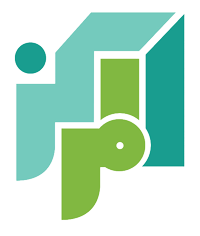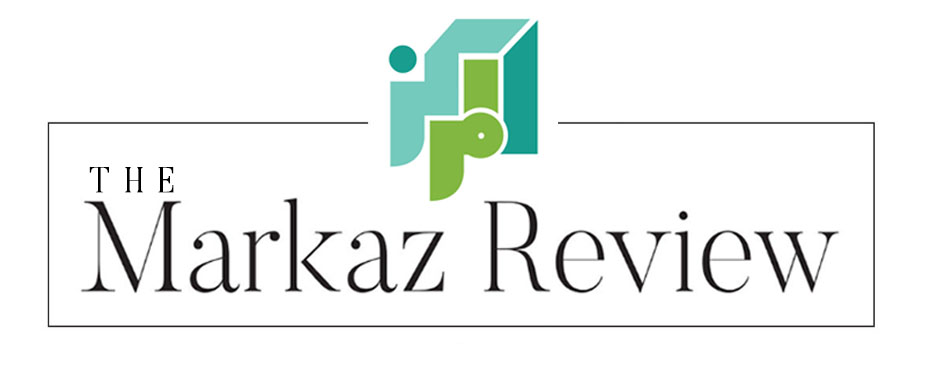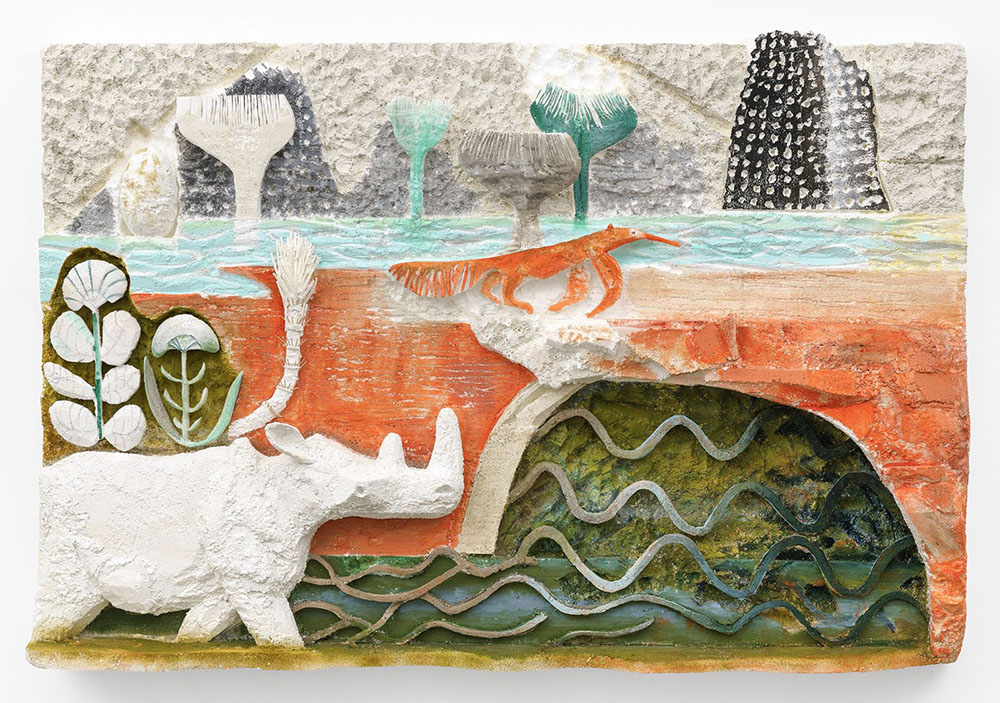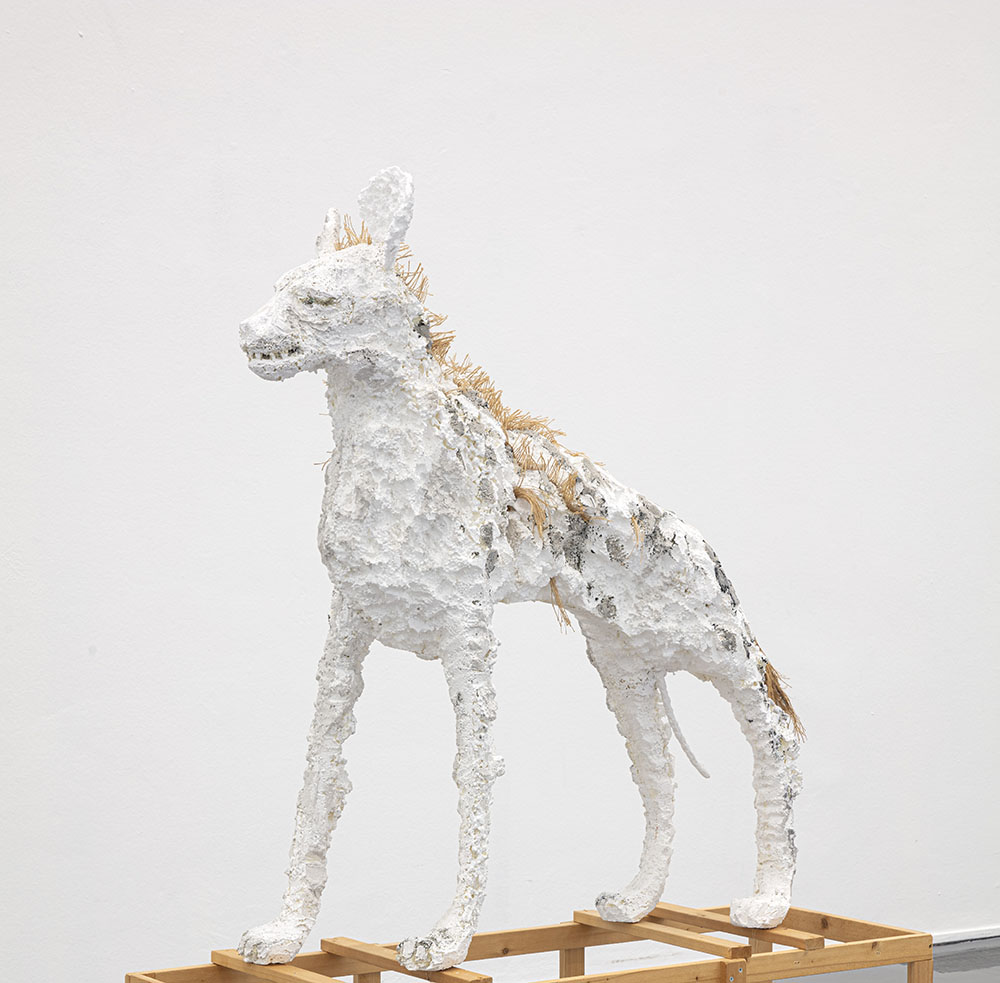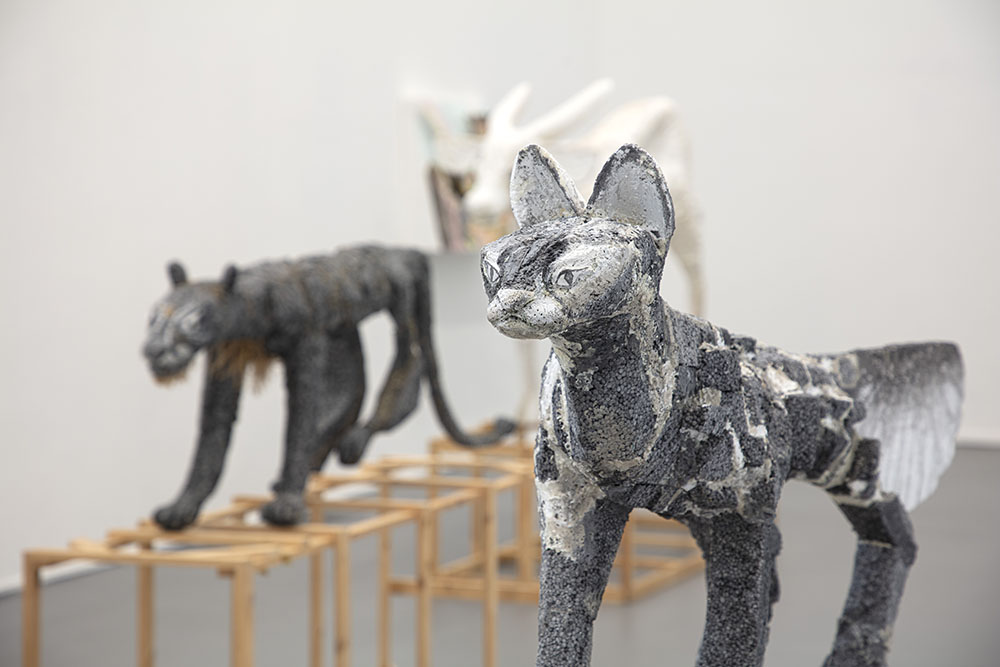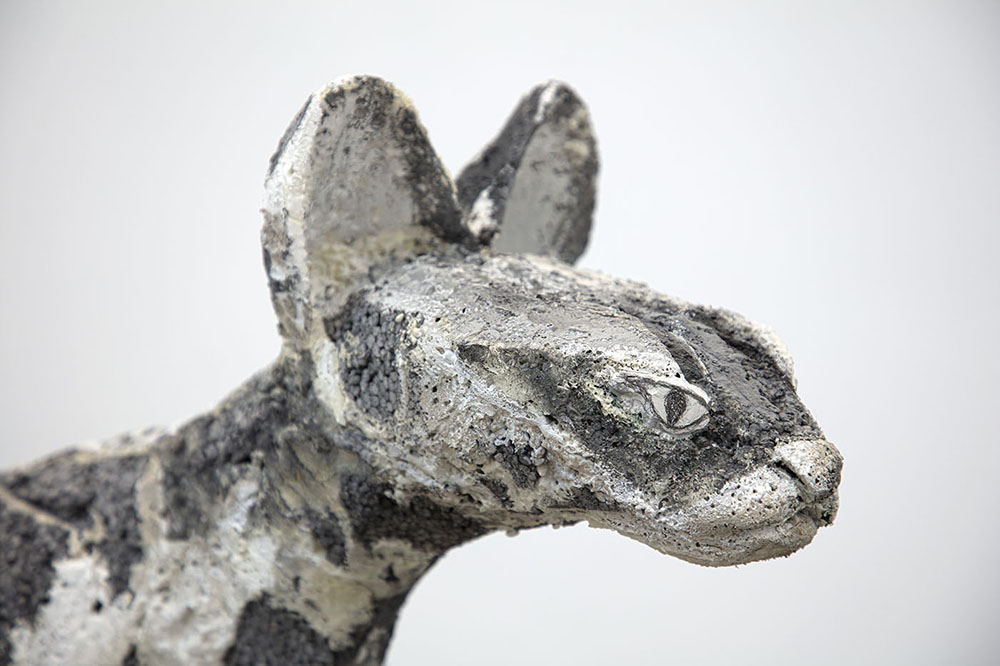…Lin May Saeed’s work sought to reestablish lost relationships with animals, whom she viewed as humanity’s equals. Her sculptures were rooted in the politics of the animal liberation movement, yet they rarely made direct pronouncements about how we should relate to the menagerie of cats, panthers, pangolins, lions, calfs, camels, and foxes that she depicted. —ARTnews
Arie Amaya-Akkermans
The presence of the white pangolin, the only mammal with the feature of protective keratin scales, represented sculpturally on a pedestal in a museum, was a striking sight. Placed on a plinth, in the manner of classical art in encyclopedic museums, Lin May Saeed’s Pangolin (2019) elevated the representation of this infamous but ultimately very threatened animal beyond zoology, poaching, illegal trafficking and the flawed association with the Covid-19 pandemic. But the late German-Iraqi artist (1973-2023) is known to have been working on the sculpture already in 2019, as a part of a long-standing series of sculptures representing animals that are not well known, or that are intensely exploited in the animal industry. Until her untimely death last year at the age of 50, the artist was a singular kind of activist for animal rights. She wasn’t only interested in the legal and institutional framework of rights for sentient beings, but her political imagination went much further: in her practice she envisioned a slightly utopian world, in which animals were liberated and co-existing with humans.
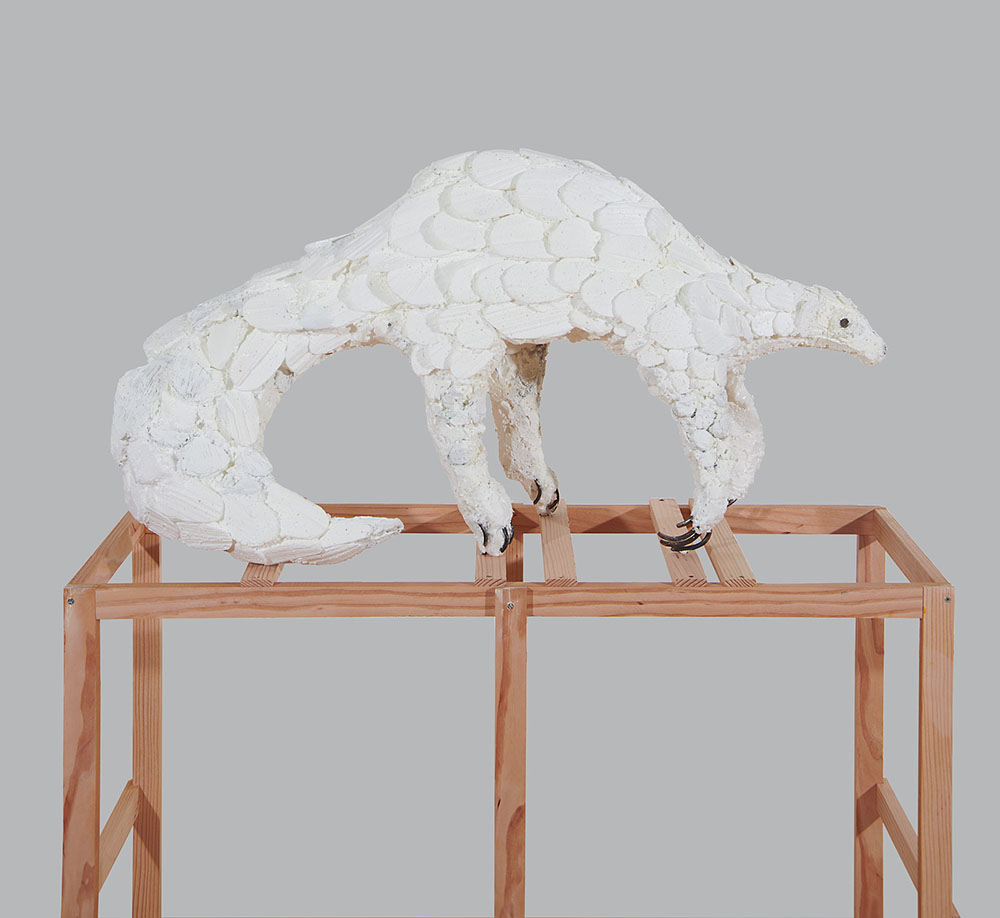
courtesy Estate of Lin May Saeed and Jacky Strenz, Frankfurt/Main).
But Saeed’s world isn’t an anthropocentric one, at the center of which stands a benevolent human, offering tolerance and protection to the animal kingdom, as a good-hearted landlord of the earth. It is a different kind of world in which animals are protagonists of their own narratives, endowed with language and agency, and not simply metaphors for human morality or human-to-human relations. In the exhibition, Thinking Like a Mountain, part of a two-year series of exhibitions at GAMeC in Bergamo examining the entanglement between humans, animals and nature (a second part of the exhibition was shown concurrently at the Biennale Gherdeina in Ortisei), curator Lorenzo Giusti introduced different parts of Saaed’s work, from a small white fox relief that seems to have come out of a children’s book, to the more monumental “Thaealab II” (2017), and lining up the walls of the generous space in the museum were a number of colorful reliefs that better articulate the rich, polyphonic, and transtemporal story that Lin May Saeed wanted to tell about the animal world.
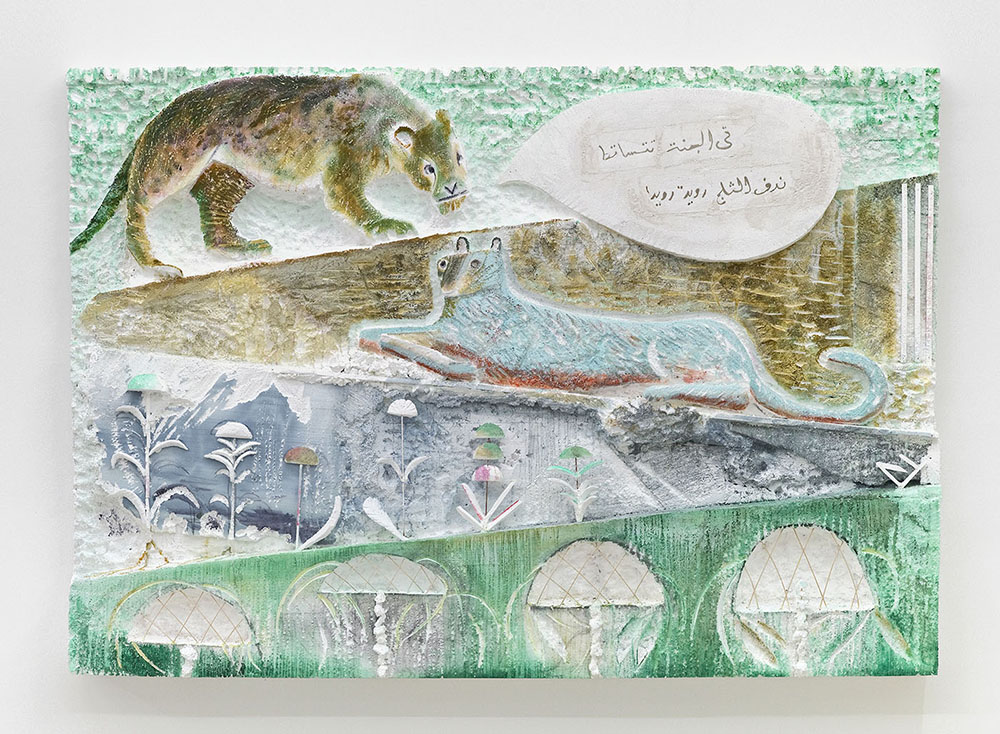
courtesy The New Institute, Hamburg).
In the relief “Mureen/Lion School” (2016), animals themselves experience difference and otherness: Lions speak to each other in Arabic, while different animate and inanimate creatures, spread throughout her work, speak their own tongues. Her relationship to Arabic and to Iraq is both fragmented and substantial: The artist was interested in Iraq, the country of her father, but she did not speak the language because of an assimilationist drive in her family (not unlike Etel Adnan). She visited Iraq in her early years but never returned due to the ongoing catastrophe of war unleashed by the American occupation. She began inserting Arabic in her work first as mere markings with a semiotic function, and later began to teach herself the language, and it served a function in her reliefs. In this relief, the lioness utters the poetic Arabic sentence “In paradise, the snowflakes flow slowly” that inspired the title of her exhibition at the Georg Kolbe Museum in Berlin in 2023, and which opened only ten days after she had passed away.
The place of the relief in prehistoric art from Mesopotamia is what holds the real thrust of Saeed’s connection to the heritage of Iraq, and her rich transposition of mythological elements and visual narratives, to engage in a sharp and passionate critique of Western anthropocentrism and modernity. The different layers of representation in the reliefs recall the Uruk vase from the Sumerian period, held at the National Museum of Iraq, one of the earliest examples of narrative relief sculpture on a vase, going back to the third millennium BCE. The work depicts three layers of carving: The vegetation around the Tigris and the Euphrates Delta at the bottom, including reeds and grain. In the middle layer there are nude men carrying bowls with sacrificial offerings of fruit and grain, and in the upper layer there’s a fuller view of the whole, rather than a different scene: The procession ends at the gates of the temple, and goddess Inana, stands in front, and is offered the bowls with the sacrificial offering. The king of Uruk is dressed in a ritual kilt and leads the procession facing her.
The relationship between Saeed and the ancient reliefs was so meaningful that the Vorderasiatisches Museum, a colonial collection including a plaster copy of the Uruk Vase made several decades ago, collaborated with the Georg Kolbe Museum, holding tours of the prehistoric reliefs, before the Pergamon Museum was set to close for the following two decades. The Uruk vase in fact is not just any other historical vase, but a triple ruin: Its historical value was appreciated already in antiquity, time during which it was broken and repaired. It was then one of the thousands of archaeological artifacts looted from the National Museum of Iraq in 2003, and later returned. The vase was once again in pieces, but at least it had all fourteen pieces, and it was re-restored in the following years. Saeed is not the only contemporary artist to have taken an interest in Mesopotamian art; Michael Rakowitz’s re-apparitions of Assyrian and Neo-Assyrian reliefs as well as of looted artifacts from the National Museum of Iraq have been exhibited worldwide.
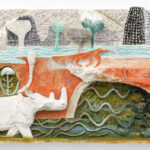
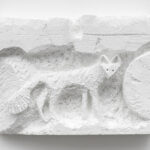
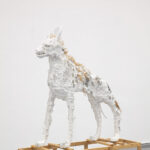
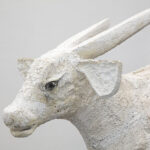
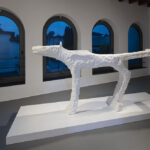




But Saeed remains more ambitious philosophically, insofar as she is not interested in human metaphors or in the archaeological imagination of the past per se, and rather in a more transtemporal, transformational, intersectional gesture. It is about turning upside down the utilitarian hierarchies of social relations that fashioned the world into the binary of human and animal. It’s an intensely violent world ripe with contradiction, born not necessarily out of religion or faith, but from the antinomies of reason: Nature and culture, civilization and barbarism, North and South, ancient and modern. In that narrative relief from Uruk that was broken and pieced together, to be broken again and yet reassembled again, Saeed finds a trust and power of continuity in the world that is not the teleological narrative of history from an animal-humanoid beginning to modernity, and ultimately the apocalypse. Instead, it is a fluid universe in constant becoming, where the human is always part animal and vice versa, and landscapes, things, peoples and beings are mutually constructed and always in flux.
In a series on which Saeed worked for over a decade, The Liberation of Animals from their Cages (2007-2020), we can see many tales of resistance and liberation, where animals escape from imprisonment in the human world, even bolting their way out of a meat factory. But these are not simply moral stories meant to uplift the spirit or praise existing social norms. Their utopian character invites us to consider the possibilities of different worlds, of different social arrangements, and different, more complex conceptualizations of a nature we are part of, not a separate metaphysical entity or outer world, for there’s no outer world from nature other than the cosmos itself. According to philosopher Fahim Amir, Saeed gives hope, along with other forms of agency and emotion, back to the animal world by means of not circumscribing hope to language, and therefore worldliness to intelligibility with humans. If animals were free and not private or state movable property, they would exercise autonomy differently, and therefore, could enter in and out of social arrangements, with or without us.
But Amir tells us that this hope comes from the darkness rather than from the light: There’s so much despair in the animal world, and in making us aware of this despair the artist sheds light on the necessity of hope, and not as an exclusively human attribute. The hope for liberation in the animal world is obviously tightly intertwined with the end of the world-system of colonialism, and with reparative and epistemic justice all over the world. Going through one of the most violent and uncertain moments in the history of modernity, when there’s a systemic failure in our institutions and so many people are suffering, particularly in the Middle East, Lin May Saeed left us too early, because we are in urgent need of this hope. Experiencing her work for the first time in Bergamo this year, amidst so much political and existential homelessness, made us wish for all those possibilities of different worlds and horizons of freedom, in which we ourselves have true agency and live not simply at the mercy of survival labor, capitalist realism and and an impoverished political imagination.
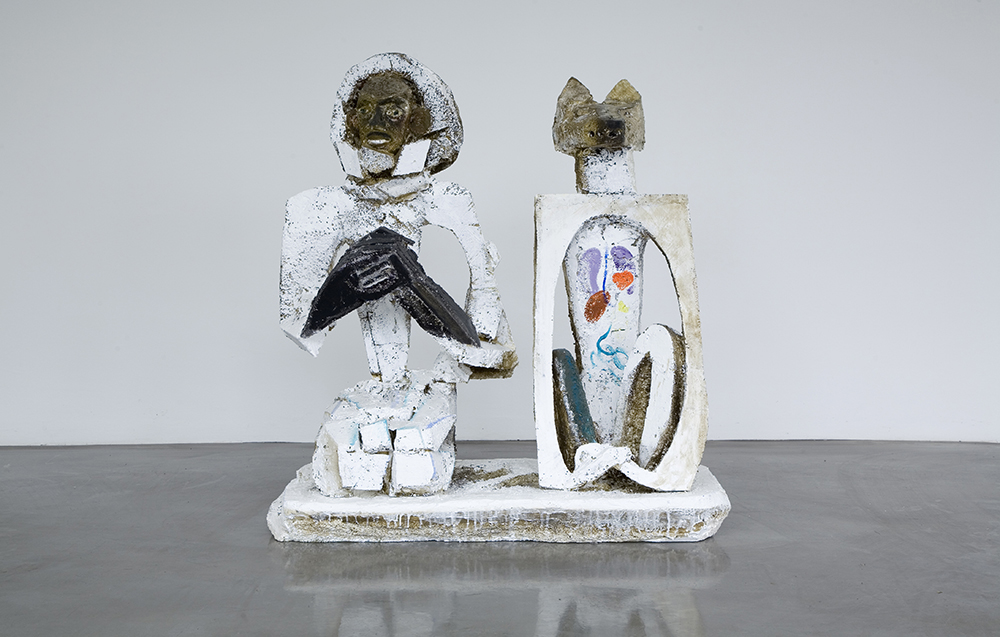
courtesy of the Estate of Lin May Saeed and Jacky Strenz, Frankfurt/Main).
Saeed’s reading of the Gilgamesh Epic, the first half of which centers around Gilgamesh the King of Uruk, and Enkidu, a human from the wilderness, created by the gods to stop Gilgamesh from oppressing the people of Uruk, reappears in several of her reliefs. Enkidu’s story encapsulates the paradox of humans being part of nature and yet exiled from it. Curator Lorenzo Giusti recounts in a conversation with Amir and others about Saeed’s work: “Enkidu is a wild man, raised among animals of the steppe, isolated from civilization and in close connection with nature. When after being seduced by a woman, Enkidu discovers that he’s human, the animals exile him. Enkidu’s exile is the archetype of breaking the covenant with the wilderness.”
Can we ever unmake this rupture? The Eridu Genesis, or Sumerian creation myth, found in a tablet excavated at Nippur is only fragmentary, but it does tell us that although humanity was sent to build cities and become sedentary, they angered the gods and were destroyed in a flood. Only the animals and Sumerian king Ziusudra survive.
But the relationship of Lin May Saeed to ancient art, might in fact, go deeper in time than the Mesopotamian myths of the Bronze Age, and take us into the relatively uncharted, porous and poorly understood world of Neolithic idols from Europe and the Middle East, mostly in the form of a radical zoomorphism as the primary symbolic form, at a time when our political and cultural institutions were still nascent and so many possibilities were open, to the degree that peoples chose to live in new social and political orders than the ones they had been born into, or returned to earlier arrangements, including for example, the rejection of agriculture. For artistic representation it meant that Neolithic idols were both zoomorphic humans and anthropomorphic animals, but also gods, mother-goddesses, females and males, warriors and scribes. In this spirit of Neolithic zoomorphism, Saeed’s work often showcases species that have become blurry, between canine and feline, living and extinct, between human and animal. And some of her species are altogether speculative. One of these strange creatures, the sculpture Serval (2018), of a wild cat from Africa, will be on show this month in Dubai at Jameel Art’s exhibition Three Tired Tigers.
In a series of fables that the artist wrote in the early 2000s, exploring interspecies coexistence, she expands (perhaps for the only time, since she remained rather silent about the meaning of her work) on the misconception of the dualism between human and animal, or between culture and nature, when it comes to the care for the world, in a conversation between different species, about habitat: “Hi there, how do you live?” The rabbits answer: “We live in small groups, have no fixed partnerships. Build widely branching tunnel systems, in which our young are born, naked and blind. We also reproduce when imprisoned.” The hare adds, “I live solitary. Sleep in a shallow hollow. My offspring are born with fur and open eyes. I have never been domesticated.” Finally it’s the turn for humans to answer the question, an answer that would have been as true of the Bronze Age as it is of our own times: “We don’t quite know. Until we have found out, we wage wars.” In other words, we bear an enormous responsibility for animals, as the most destructive tenants the world has seen yet.
Lin May Saeed also pointed a finger at this process of destruction through her choice of material: Rather than marble or wood, the artist has chosen Styrofoam, a material that is both fragile and durable, and in fact, so durable that it will outlive us and many of the animals in her sculptures, who are now endangered or even possibly extinct. Searching for closed-cell extruded polystyrene foam in construction sites in the never-ending real estate boom of Berlin, the artist expresses in these delicately carved and painted sculptures, the result of intense physical labor, a commentary on modern industrial societies, and the extravagance of consumption. The anthropocene is here not only a geological period passively unfolding before our helpless eyes, but an act of violence committed against life on the planet as a whole, by the humans who allegedly benefit from modernity.We also have the power to change this nefarious social and political order in the same way that our Neolithic ancestors chose to step out of convention, to create new worlds in which we are still partly living.
In his 1980 essay “Why Look at Animals?” John Berger tells us, “To assume that animals entered the human imagination as meat, leather or horn is to project a nineteenth-century attitude backwards across the millennia. Animals first entered the imagination as messengers and promises.” The artistic project of Lin May Saeed delivers a similar message, but at a time when the meaning of animals has changed, from Berger’s rather conservative view of domesticated animals as a kind of souvenir from nature, to a time when the imaginary of animals has conquered the Internet, house pets have become more than sentient beings or companions for modern families, and indigenous ontologies from all over the world have exposed us, in one way or another, whether it is through popular culture, films or scholarship, to different forms of knowledge from the past, in which our ancestors shared with animals not only a habitat, but often ritual and symbolic roles. Any project of decolonization today is also an environmental project, an animal project, it’s a world-project, both human and non-human.
It is an interesting coincidence that in the middle of the 2010s, while Lin May Saeed was working on her Cambrian Relief (2016), depicting the beginning of animal life on earth, the prestigious academic journal Archaeological Dialogues, published a 64-pages conversation between prominent archaeologists, spearheaded by Yannis Hamilakis and Nick Overton, with a proposal for a social zooarchaeology that explicitly went beyond the utilitarian logic that saw animals as important insofar as they were of benefit to humans, whether it was for symbolic or pragmatic reasons. How to think about animals beyond being resources? They were keen to note that although many recent approaches in the humanities have focused on the agency of things and artifacts in their entanglement with humans, non-human animals are still absent, due to the anthropocentrism of Western thinking. But as Lin May Saeed knew very well, our first encounters with animals helped us configure our own humanity. First we looked at them, and when they looked back, we knew who we were, and we knew who they were. Berger concludes: “Animals came from over the horizon. They belong there and here. Likewise they were mortal and immortal.”
When we open our phone screens and see the dead animals in Palestine and Lebanon — cattle, house dogs, birds, stray cats, or the few that have been miraculously saved, we feel profound grief and shame. This shame is qualitatively different from the one we feel for other human beings. We must have empathy with our species, we know their stories, we know of their suffering, we have witnessed it, and we can speak to each other, remember, seek justice. But with animals, the symbolism becomes immediately stronger because we, collectively, were their guardians, who failed to care for their world. Their violent deaths strip us of promise and hope; the promise and hope of return, of rebirth, of the resilience of life which they represent. Lin May Saeed is no longer with us to continue cultivating this hope in her infinitely touching reliefs, but when we see them today, it is impossible not to feel the grief of this present moment, the necessity of that hope, of the belief in another time, in a different world.
See more of Lin May Saeed’s sculptures here.
